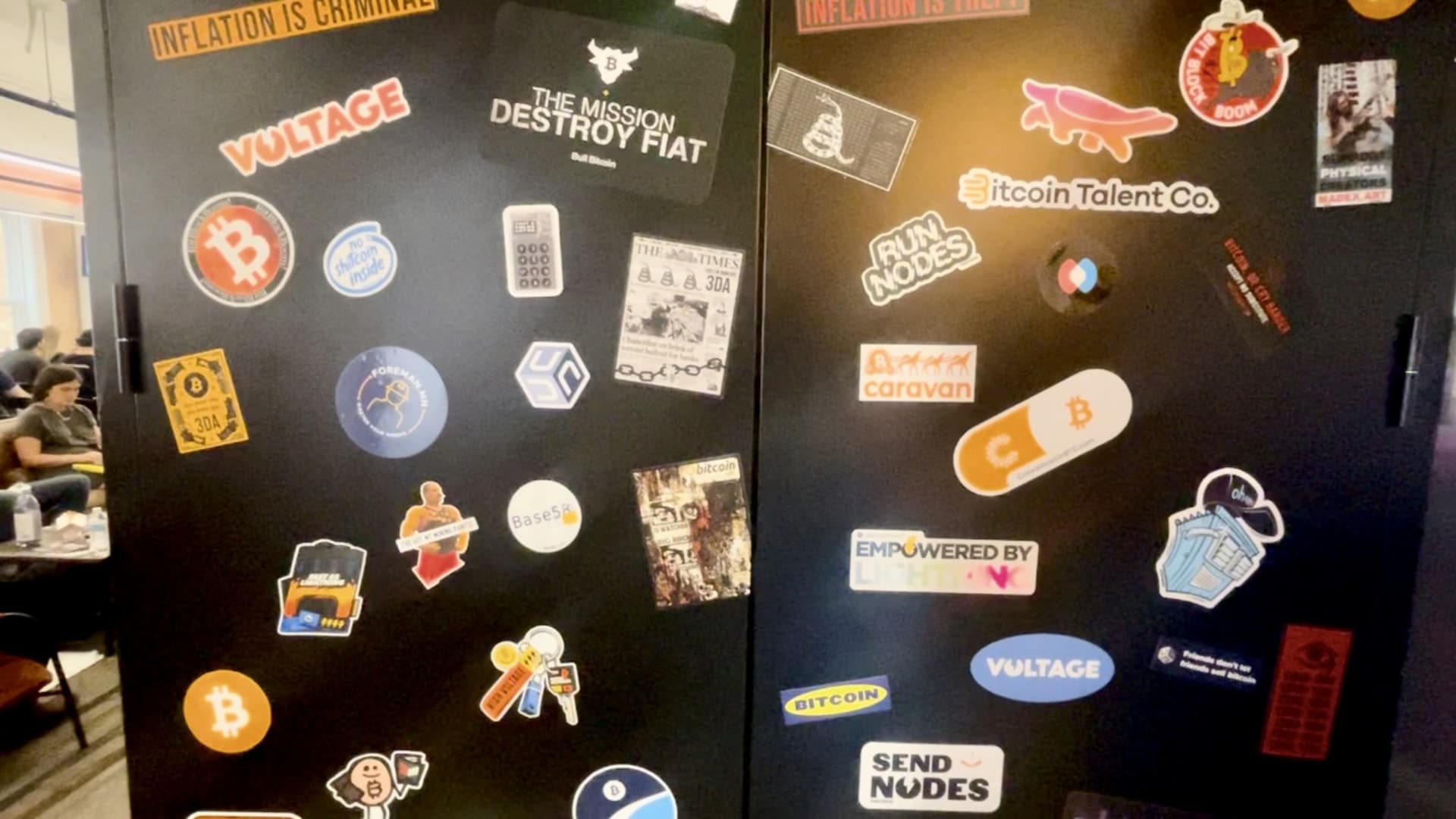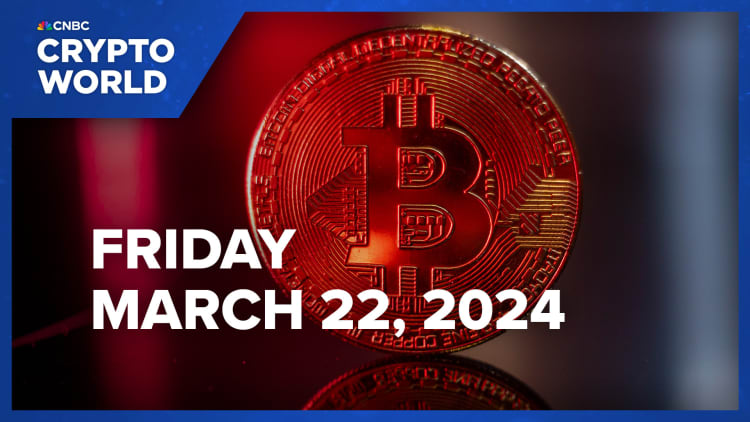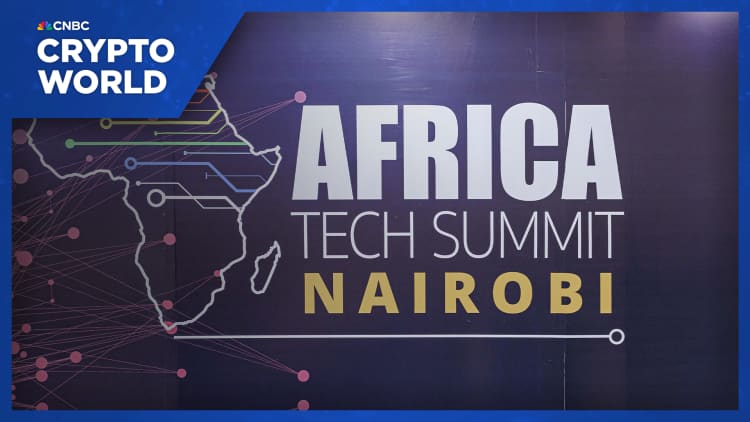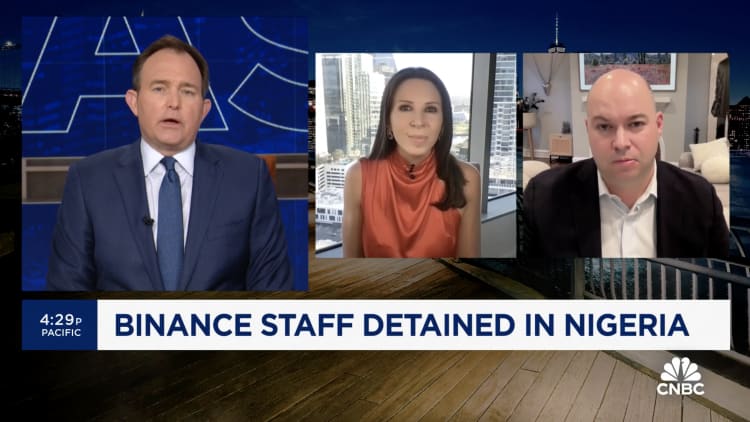

AUSTIN — There is a sort of clubhouse for Austin’s bitcoin believers on the second floor of the Littlefield Building at the corner of Congress Avenue and Sixth Street. The hideaway is at the crossroads of two worlds — the majestic thoroughfare that leads to the Texas State Capitol and the iconic, albeit notorious, stretch of bars, restaurants, and live music that define the capital’s party vibes. It’s an apt metaphor for the space itself.
The Bitcoin Commons is, at once, many things.
By day, it functions as an open plan, fluorescent-lit co-working space for the more corporate-minded bitcoin operators, but at night, it moonlights as a safe space for underground meet-ups of the industry’s rogue actors. Periodically, it plays host to conferences that draw in a mix of attendees ranging from venture capitalists to armed preppers living entirely off the grid. And on some afternoons, once happy hour hits, the kitchen at the back is retrofit with a stowaway bar.
“We also fund developers, and we help them advance their projects,” said Parker Lewis, one of the stewards of the Commons, as well as the author of a new book on bitcoin called “Gradually, Then Suddenly.”
“We help advance bitcoin through education and actually developing the monetary network, the code base, and the applications,” said Lewis, who is widely considered to be one of Texas’ de facto bitcoin ambassadors.
Francisco Chavarria was born in Mexico City and spent time in Salt Lake City, but three years ago, he made the move to Austin to be a part of a community of like-minded thinkers. His company, Yopaki, which is a neobank for bitcoin focused on the Latin American market, just won first place in a hackathon put on at the Commons.
“If you talk to other builders in the competition, a lot happens here,” said Chavarria. “There definitely is a sense of, ‘I don’t need for others to lose for me to win.’ There really is a relationship and a collaboration for bitcoin to succeed.”
“Right now it feels like we’re all winning because of the price, but those of us who have been building in the bear market, we know,” Chavarria added.
Austin’s “Bitcoin Commons” hosts regular meetups and conferences for the city’s bitcoiners.
CNBC
Bear or bull market, bitcoiners have flocked to Austin because of a combination of pro-crypto policies, abundant, renewable energy, and an ever-growing network of some of the brightest developers and miners on the planet. And even in the price doldrums, they typically bring the same level of enthusiasm to the conversation — though bitcoin’s recent stretch of record-breaking price moves has gone a long way toward boosting morale.
In March, bitcoin hit multiple, fresh all-time highs, as trader enthusiasm for the digital asset sector soared. A lot of that price run-up has to do with the record flows into the newly-launched spot bitcoin exchange-traded funds in the U.S., led by the world’s largest asset manager Blackrock and its $15.5 billion iShares Bitcoin Trust, which have helped to solidify bitcoin’s place as an asset class that’s here to stay.
Collectively, these spot ETFs have brought in around $60 billion, and in some cases, they have been breaking records for ETF flows altogether.
“The biggest driver is certainly the ETF flows, which have surpassed the expectations of all but the most bullish pundits,” said Castle Island Venture’s Nic Carter of bitcoin’s record price moves this month. “And these blockbuster flows have materialized before the major wirehouses, asset managers, and RIAs have actually approved the ETF for their clients.”
Carter added that there is also new liquidity coming into bitcoin from Asian markets via two main pathways: bitcoin’s version of non-fungible tokens known as ordinals, as well as bitcoin-issued coins called BRC20 tokens.

Underground vibes with an open bar
In the last 20 years, Austin has matured into one of the country’s leading tech centers, a trend accelerated by the Covid pandemic, which saw industry leaders migrate en masse from California.
“Bitcoin was founded in 2009. A lot has happened post-financial crisis. Austin was already emerging as a tech center, and you know, enter bitcoin, and it just became the logical home,” said Lewis, who runs business development at Zaprite, a bitcoin-native financial services firm.
It helps that Texas is a libertarian-friendly state that actively supports free market policies. It has proven to be a big draw for a group of people who think of bitcoin as a way of life — that is, a monetary network that is decentralized, borderless, and doesn’t answer to central banks or governments.
Austin’s “Bitcoin Commons” draws in an eclectic mix of people, including venture capitalists, bitcoin miners, and coders.
CNBC
Many hardcore bitcoiners ironically embrace the term maximalist or maxi as a way to self describe. In Texas, though maxis exist along a professional spectrum from venture capitalists, to miners, coders, company executives, and generalist techies, the eclectic tribe have a few things in common. Many are family-oriented, patriotic carnivores with an aversion to the overreach of government and a strong belief in the right to bear arms, among multiple other personal, individual liberties.
Bitcoin’s eponymous Austin lair, which is adorned with the Texas state flag and bitcoin memorabilia, has adopted Chatham House rules for many of its events to protect the identities of those conversing within its walls. One such meetup is the monthly BitDevs (short for bitcoin developers) gathering, where bitcoin builders, investors, and the bitcoin curious are all welcomed, so long as no pictures or videos are taken.
At these meetings, topics run the gamut, from detailed discussions about code to concerns that the Microsoft-maintained GitHub may pose a greater existential threat to the bitcoin network since much of the development work and conversations among coders happen on that platform. At one such gathering, the moderator of the two-hour session asked the room who ran a bitcoin node. More than half of the people in attendance raised their hands.
After attending multiple Austin BitDev meetups over the last three years, a few common conversation themes have emerged, including the focus on identifying threat vectors to the network and brainstorming workarounds. Beyond software, there are also concerns over hardware vulnerabilities, given that the ASIC chip used in bitcoin mining rigs are manufactured out of China, a country which has proven hostile to the crypto sector in recent years.
The “Bitcoin Commons” functions as a sort of clubhouse for the city’s bitcoin believers. It puts on a mix of programming, including conferences and hackathons, as well as hosts a co-working space by day.
CNBC
VCs flock back to bitcoin
The Commons hosted a hackathon, BitDevs, and a one-day conference dubbed the Bitcoin Takeover on the sidelines of the annual South by Southwest tech festival, which put on virtually no crypto programming this year.
Across those multiple gatherings, there was a newfound interest in talking about the burgeoning ecosystem of projects building on top of bitcoin’s blockchain, which began to heat up with the introduction of ordinals in Jan. 2023 — bitcoin’s version of non-fungible tokens.
One underrated driver of bitcoin’s recent rally is new programming innovations that may allow it to reach technological parity with ethereum. These advancements involve beefing up the bitcoin ecosystem with tools like smart contracts, which are programmable pieces of code that help to eliminate middlemen like banks and lawyers from transactions. That makes it easier for developers to create products and applications for consumers.
BitVM, for example, has a promising plan to do just that. It is ultimately trying to bring smart contracts to the bitcoin network, which has helped spur this renaissance of interest in layer two technology — that is, the startups being built on top of bitcoin’s base chain.
“I’ve never seen deal pacing move this aggressively in the bitcoin space in my entire career,” Carter tells CNBC.
Indeed, the VC appetite for these layer two bitcoin projects has been picking up in the last few months.
PitchBook says that the fourth quarter of 2023 was the first time in almost two years that deal value in the crypto sector had increased, reaching $1.9 billion — up 2.5% from the previous quarter. While still well off the 2021 high of $31 billion, funds are building back interest, and trust, in the space.

Grant Gilliam spent 15 years working in private equity in New York before pivoting to run a bitcoin VC fund called Ten31. This investment platform, which is focused exclusively on bitcoin, has invested $125 million of equity in aggregate since launching five years ago. More than $100 million was deployed in the last two years during the bear market.
“We invest across the bitcoin ecosystem across every major theme,” Gilliam told CNBC. “Anything that is relevant to bitcoin infrastructure, we like to say the picks and shovels of companies building products and services for holders of bitcoin.”
Gilliam, who spent a few years commuting from New York to Austin every month for the BitDevs meetup, said that some of the layer two bitcoin investments are more hype than substance, but he’s still bullish overall on the deal space.
“There’s been a lot of L2 hype lately, mainly driven by the ordinals, and inscriptions, developments or innovations, if you want to call it that,” Gilliam said. “There’s a lot of activity in that right now, but we haven’t been as focused on that. It’s our firm view that the ordinals will prove to be a passing fad.”
Gilliam says that Ten31 is focused on basic building blocks of the ecosystem, such as companies that are providing financial services, which could be custody trading and lending, or projects that are working to scale the lightning network.
Lightning, with is the layer two payment technology meant to realize bitcoin’s original vision of being peer-to-peer cash continues to struggle with the issue of reaching scale. Developers tell CNBC that a lot of engineering work remains to close that gap.
The Boys Club put on its own Austin summit on the sidelines of SXSW with programming on the new internet, crypto, and digital culture.
CNBC
Bitcoin-halving country
“Number go up” is a big mantra among bitcoiners, but as the community evolves, so too does the thinking about the price of the coin.
“Price is really an output of many inputs of human beings, building tools to make bitcoin both more secure and a greater utility,” Lewis said. “Price is the best indicator of more people coming to the conclusion that bitcoin is money, and it’s a better store of value, so it is very relevant.”
Every four years, bitcoin undergoes a market making event known as the halving. It cuts the production of new bitcoin in half, and it has typically come before a major run-up in the price of bitcoin.
Miners from around the world flocked to Texas when China banned the practice in 2021, attracted by the abundant renewable energy and a grid that’s friendly to flexible buyers of power — both ideal conditions for miners.
In April, however, the profits for these bitcoin miners will be cut in half.
For some, it may prove an Armageddon-level event. Others have braced for impact by swapping out their fleet of machines for more efficient rigs. The price run-up in bitcoin has also helped to give some of these companies a buffer in their profit margins.
West Texas miner Jamie McAvity has 60 megawatts at his mining site. It runs on a part of the grid that is 90% powered by a mix of solar and wind power.
“If you’ve been in for more than one cycle, you have situated yourself in a place where you can resist the halving to the best of your ability,” McAvity told CNBC at Austin’s Bitcoin Commons.
McAvity, who previously worked for ten years as a trader on the floor of the New York Mercantile Exchange, added that ETF flows have helped to change the pricing dynamics for the world’s largest coin.
“The spot ETF inflows are so massive that reducing the available supply of newly mined bitcoins from 900 to 450, is probably going to be immaterial relative to that,” he said.
“But who knows, the ETFs could cool off for a while, and it’s hard for someone to credibly say that a reduction in supply is not going to change the market price equilibrium, because that’s a fundamental principle of market economics,” he added.

Altcoin mania
A ten minute walk west from the Bitcoin Commons is the Austin Proper Hotel, a five-star establishment where the lighting is intentionally dim to strike a certain mood. Here, the Boys Club, a popular and buzzy, female-led organization which self-describes as a “social collective bringing new voices to the new internet” put on its own crypto conference on the sidelines of South by Southwest.
The Boys Club caters to a more blockchain agnostic crowd, where the focus is less on exclusivity to one coin or chain — and more about borrowing the best features from across the ecosystem to solve problems in the real world.
CNBC caught up with Micha Benoliel at the one-day summit. Benoliel built Nodle, a decentralized wireless network that’s now getting into the business of using the blockchain to battle AI-powered deepfakes.
“Blockchain is the only way to make a record that is immutable, and is going to prove the time at which this photo has been taken, or video, and also to help you prove the location and other elements that are going to reinforce that proof, so it creates a real immutable proof of authenticity,” he said.
The Boys Club put on its own Austin summit on the sidelines of SXSW with programming on the new internet, crypto, and digital culture.
CNBC
The one-day popup event gathered together more of a web3 crowd to talk about everything from the latest trends in tokenization to the resurgence of on-chain meme culture.
Similar to other bull runs in the price of bitcoin, some altcoins have seen a meteoric rise alongside blue chip names in crypto, because they’re seen as a comparatively cheaper buy.
Dogecoin, a meme-coin that was started as a joke, now has a market cap of nearly $25 billion, placing it in the top ten most valuable cryptocurrencies on the planet. Boden, a coin named after President Joe Biden, saw a run-up of more than 800% in a six-hour window after Super Tuesday, and the newly popular DogWifHat is collectively worth more than $2 billion.
Typically, this is the bellwether of a peak bubble moment, but analysts say that despite frothy conditions, this bull run is different to past cycles.
The price of bitcoin is cyclical, and it sees price run-ups roughly every four years. Each time, the price floor is higher. What’s also a departure this time around is the fact that institutional money is here in a way that it hasn’t been during past bull runs.

Fundamentals in the crypto market are playing a big role, as well.
In a note from JPMorgan on Mar. 15, analysts credit ether, the world’s second-biggest crypto token by market cap, for being a significant driver of crypto’s recent gains, including Coinbase‘s stock price rise. Ether has rallied nearly 50% so far this year, recently breaching the $4,000 price level and outpacing bitcoin’s returns, before paring back some gains.
“While the focus of the cryptocurrency marketplace has been the net new money going into U.S. spot Bitcoin ETFs and the positive impact on Bitcoin token prices (here, the spot Bitcoin ETF and its ultimate launch in January has driven the cryptoecosystem over the past several months), we see impact of ETH appreciation also as particularly meaningful,” JPMorgan wrote.
Regulators in the U.S. remain a universal concern for the crypto sector, especially amid reports of the Securities and Exchange Commission probing crypto companies building on the ethereum network.
Still, many in the space, including coders and investors remain optimistic.
Ethereum, the blockchain that underpins ether, underwent a major upgrade on Mar. 13 dubbed Dencun. Developers told CNBC it was expected to slash transaction fees by up to 90%. That is game-changing not just for the end-users, but also for the coders building apps on top of ethereum.
Base, crypto exchange Coinbase’s self-built layer two network, is ethereum-based and allows developers to more easily build decentralized apps. Coinbase’s Base lead, Jesse Pollak, anticipates this will open the door to applications in both the gaming and decentralized social media arena now that it is no longer nearly as cost prohibitive to build these types of programs.
“The thing that is happening with Dencun is we’re going to create a whole new kind of storage on ethereum that’s purpose built for Layer 2s like Base,” Pollak told CNBC.
“That means that right now we pay a ton to ethereum, and we’re going to pay a lot less, which is going to lower the fees for everyone. Because ethereum is basically going to build a product purpose built for us,” continued Pollak.
Chris Dixon, crypto chief at venture firm a16z, echoed that sentiment, noting that part of their portfolio is focused on these startups.
“The core idea is that if you build a social network, or a game or a financial service, on top of the blockchain, it has all sorts of benefits where the money and control flow out to the users and the creators that access the network, as opposed to the companies that control it,” said Dixon. “In the same way that steel was a better way to build bridges and buildings than wood was in the Industrial Revolution, blockchains are a building material.”







